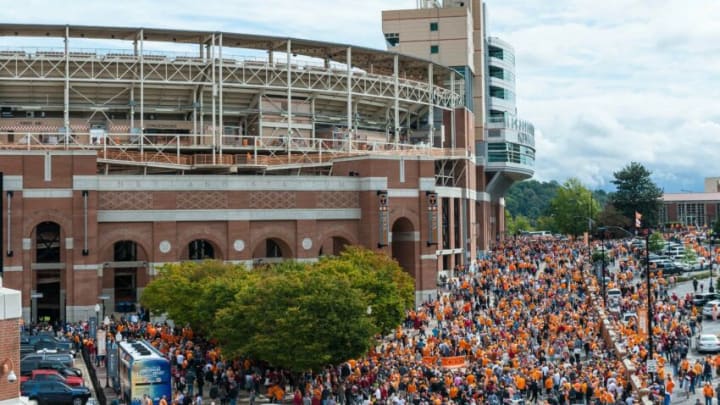All the excitement in the world can’t take away the major advantage Tennessee football continues to lose with the news surrounding the new Neyland Stadium renovations. Approved by the board of trustees and revealed last Friday, there are admittedly a lot of things to like about the stadium.
Rocky Top is adding a jumbotron to the north end zone. They are adding Stadium WiFi, an updated sound system and new nice plazas and lounge areas. Most notable, though, is the restoration of the V-O-L-S letters on the stadium, which will be laid out in the way they were before 1998 rather than bunched together on a jumbotron.
Many fans consider that change, which began in 1999, and eventual removal of the letters over a decade later to be the supernatural force behind Tennessee football’s downfall. They’re wrong. The real force is much more tangible, and these renovations continue the issue: falling in the stadium size rankings.
Following a report from Mike Wilson of the Knoxville News Sentinel, Wes Rucker of GoVols247 noted that a source confirmed the renovations would shrink the stadium capacity size from 102,455 to 101,915. The move drops the Vols’ stadium size down one spot to sixth in the nation, just behind the LSU Tigers’ Tiger Stadium.
You can point to many reasons for Big Orange Country’s slide the past two decades, which includes no SEC Championships in now 23 years. However, their slide down the national rankings in terms of largest college football stadiums coincides more with that than anything else.
In 1996, with the addition of the North end zone upper deck, Tennessee football had the largest stadium in the nation, surpassing The Big House, where the Michigan Wolverines play, for two years. They won the SEC Championship in 1997 and 1998, and the national championship in 1998.
That year, Michigan surpassed the Vols in stadium size again. From 1999 to 2001, they still had two top 10 finishes and one top five finish in three years. However, in 2001, Beaver Stadium, the Penn State Nittany Lions’ stadium, expanded to move ahead of Neyland, pushing it to third. UT hasn’t had a top 10 finish yet.
Upgrades to Neyland forced it to actually reduce its capacity in 2006 by over 2,000 seats, only its second reduction ever in first ever of more than 150 seats. The Ohio State Buckeyes then moved ahead of them by increasing Ohio Stadium to 102,329 in 2007, and that just so happens to be the last year the Vols won the SEC East or won 10 games.
This isn’t some supernatural curse. By allowing stadiums to surpass them, the Vols have been losing a huge recruiting advantage they used to have. It’s no coincidence that every year they slide a spot in the rankings happens to be the last year they accomplished something.
Just as they were falling, other schools were rising to make Tennessee football’s advantage more miniscule. UT and Michigan entered the century as the only two schools with stadiums that had a capacity of over 100,000 fans. They are now among eight schools with that profile.
Penn State joined in 2001, Ohio State joined in 2007, and Texas A&M and LSU joined in 2014. To make matters worse, the Alabama Crimson Tide, who played their alternate home games in Birmingham from 1927 until 2003, including every home game vs. the Vols from 1932 to 1997, expanded Bryant-Denny Stadium.
Finally just focusing on that stadium in Tuscaloosa, Ala., allowed them to push its capacity to to over 90,000 in 2006 and over 100,000 in 2010. Finally, the Texas Longhorns pushed Darrell K Royal–Texas Memorial Stadium in Austin to over 100,000 in 2009.
Add in the Georgia Bulldogs pushing Sanford Stadium to over 90,000 in 2003, and there’s a reason the 2010s are the worst decade in Tennessee football history. This was a huge advantage that Vol fans enjoyed, and it’s completely gone.
You can trace this back to 1980. That year, under Johnny Majors, Rocky Top increased its stadium size to 91,249, which remains its largest net gain in any expansion. That made Neyland the second largest at the time, joining Michigan as the only schools with a capacity above 90,000.
Well, after 1980, the Vols were about to begin a period in which they made 23 bowl games in 24 years and won five SEC Championships and a national championship during that period. The only time they missed a bowl was 1988, ironically a year after the only other time they slightly reduced their stadium size.
Simply put, despite upgrades to the stadium, the Vols need to find a way to push Neyland back up the rankings. Danny White does a good job staying ahead of the curve on things, but you can only have advantages on updates for so long unless you keep doing that forever.
If Neyland’s stadium size won’t be the significant advantage it once was for Tennessee football, particularly in the SEC, White needs to find a more permanent advantage. Maybe it is NIL money. However, reducing stadium capacity and where Neyland stands in the rankings doesn’t bode well based on history.
